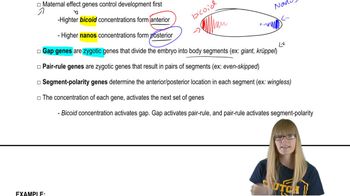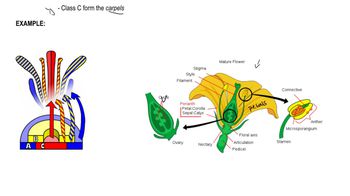Table of contents
- 1. Introduction to Genetics51m
- 2. Mendel's Laws of Inheritance3h 37m
- 3. Extensions to Mendelian Inheritance2h 41m
- 4. Genetic Mapping and Linkage2h 28m
- 5. Genetics of Bacteria and Viruses1h 21m
- 6. Chromosomal Variation1h 48m
- 7. DNA and Chromosome Structure56m
- 8. DNA Replication1h 10m
- 9. Mitosis and Meiosis1h 34m
- 10. Transcription1h 0m
- 11. Translation58m
- 12. Gene Regulation in Prokaryotes1h 19m
- 13. Gene Regulation in Eukaryotes44m
- 14. Genetic Control of Development44m
- 15. Genomes and Genomics1h 50m
- 16. Transposable Elements47m
- 17. Mutation, Repair, and Recombination1h 6m
- 18. Molecular Genetic Tools19m
- 19. Cancer Genetics29m
- 20. Quantitative Genetics1h 26m
- 21. Population Genetics50m
- 22. Evolutionary Genetics29m
14. Genetic Control of Development
Developmental Patterning Genes
Problem 16a
Textbook Question
The pair-rule gene fushi tarazu is expressed in the seven even-numbered parasegments during Drosophila embryogenesis. In contrast, the segment polarity gene engrailed is expressed in the anterior part of each of the 14 parasegments. Since both genes are active at similar times and places during development, it is possible that the expression of one gene is required for the expression of the other. This can be tested by examining expression of the genes in a mutant background—for example, looking at fushi tarazu expression in an engrailed mutant background, and vice versa. Given the hierarchy of gene action during Drosophila embryogenesis, what might you predict to be the result of these experiments?
 Verified step by step guidance
Verified step by step guidance1
Understand the roles of the genes: fushi tarazu is a pair-rule gene, and engrailed is a segment polarity gene. Pair-rule genes are expressed in alternating segments, while segment polarity genes define the anterior-posterior axis within each segment.
Consider the hierarchy of gene expression: Pair-rule genes like fushi tarazu act earlier in the developmental hierarchy than segment polarity genes like engrailed. This suggests that fushi tarazu might influence engrailed expression.
Predict the outcome of fushi tarazu expression in an engrailed mutant: Since engrailed acts later, a mutation in engrailed might not affect the initial expression pattern of fushi tarazu, but it could affect later developmental processes.
Predict the outcome of engrailed expression in a fushi tarazu mutant: If fushi tarazu is required for the proper segmentation pattern, a mutation might disrupt the expression pattern of engrailed, leading to defects in segment polarity.
Conclude the potential interactions: The expression of fushi tarazu might be necessary for the correct spatial expression of engrailed, but engrailed might not be necessary for the initial expression of fushi tarazu.
Recommended similar problem, with video answer:
 Verified Solution
Verified SolutionThis video solution was recommended by our tutors as helpful for the problem above
Video duration:
2mPlay a video:
Was this helpful?
Key Concepts
Here are the essential concepts you must grasp in order to answer the question correctly.
Pair-rule Genes
Pair-rule genes, such as fushi tarazu, are crucial in Drosophila embryogenesis as they define the segmented body plan by regulating the formation of parasegments. They are expressed in alternating segments and play a key role in establishing the basic organization of the embryo. Their expression is essential for the proper development of structures that will later form the segments of the adult fly.
Recommended video:
Guided course

Segmentation Genes
Segment Polarity Genes
Segment polarity genes, like engrailed, are responsible for maintaining the boundaries and polarity within each segment of the developing embryo. They are expressed in specific regions of the parasegments and help to define the anterior-posterior axis of each segment. Their activity is critical for the correct positioning of segmental structures and for ensuring that segments develop with the appropriate identity.
Recommended video:
Guided course

Segmentation Genes
Gene Interaction and Mutant Analysis
The interaction between genes during development can be studied through mutant analysis, where the expression of one gene is examined in the absence of another. This approach helps to determine whether the expression of one gene is dependent on the other. In the context of the question, testing fushi tarazu expression in an engrailed mutant background could reveal whether engrailed is necessary for fushi tarazu expression, indicating a regulatory relationship between these genes.
Recommended video:
Guided course

Interacting Genes Overview

 11:19m
11:19mWatch next
Master Segmentation Genes with a bite sized video explanation from Kylia Goodner
Start learningRelated Videos
Related Practice


